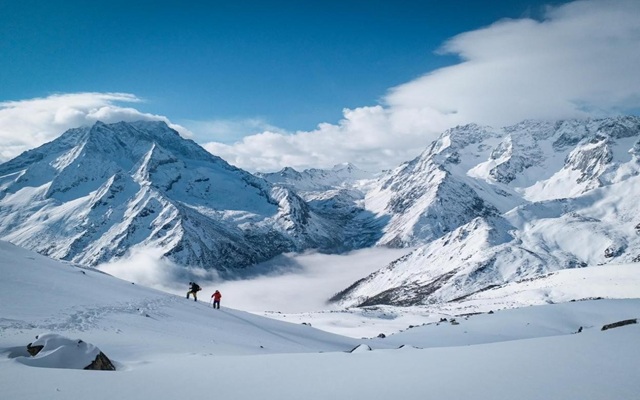Haba Snow Mountain is one of our Ice And Snow Peak Challenge . It is suitable as an entry level mountain that require basic ice and snow skills (ie: crampons, walking ice axe and fixed rope). The terrain is straight forward without crevasses. The 950m long snow slope, at the last section of the summit, famously known as the “Hopeless Slope” (绝望坡), is an onerous challenge on exposed terrain that requires a high level of fitness and endurance, but is also an ideal ground for crampons footwork practice.
Shaluli Mountains (沙鲁里山), known in Tibetan as Powor Gang, are a large mountain range in western China between the Upper Yangtze (Jinsha River) and Yalong River. The Haba Snow Mountain massif, which Haba Snow Mountain is a part of, is in the most southern end of the extensive Shaluli Mountains.
Haba Snow Mountain or Haba Xueshan 哈巴雪山 (5396m) is located in southeast Shangri-La 香格里拉 and northwest of Tiger Leaping Gorge (虎跳峡). One of the tallest peaks in Yunnan province, the peak is covered in snow all year round. “Haba” means golden flower in Naxi language. Rising opposite the higher and better known Jade Dragon Snow Mountain (玉龙雪山/5596m), legend has it that Haba Snow Mountain and Jade Dragon Snow Mountain are brothers. The two majestic mountains are wedged with the Jinsha River flowing between them, forming one of the deepest and most gorgeous gorges in the world – the scenic Tiger Leaping Gorge, a world famous UNESCO World Heritage Site.
Majority of tourists do not venture beyond Tiger Leaping Gorge to Haba Snow Mountain, except only for mountain climbers. Improved road accessibility from Lijiang to Haba Village (3 hours drive) in recent years has helped Haba Snow Mountain gained popularity, as a mountain climbing destination, among the locals and climbers from Asia.
About The Climb
Haba Village (2600m) is the base where trekkers stay before and after climbing Haba Snow Mountain. From Haba Village to Haba Snow Mountain Base Camp (4100m) is a dramatically sharp increase in elevation of around 1500m in a single day. We included in our itinerary, an additional acclimatization day in Haba Village, before heading up to Haba Snow Mountain. This additional acclimatization day, with a trek to a small peak (3500m) near Haba Village, is paramount to allow for better performance and higher success chances on summit day.
Haba Snow Mountain’s trail head (2900m) is a short drive (15mins) from the lodge in Haba Village. The trail head, which is a dirt trail that leads into an alpine forest, is not marked by any signage. Emerging from the alpine forest is an open meadow, where there is a rest hut (3600m), that is used as the lunch point. After the hut, it is a series of uphill switchback into the alpine forest again, before a short rock trail that leads to the base camp (4100m). It takes about 6-8 hours to reach the base camp from the trail head. At the base camp, there is another acclimatization day with a short day hike to 4500m. Summit day starts at around 3am on a short gentle slope up to a vast grey morainic slab left by retreating glaciers. Continue the uphill climb on the gigantic morainic slab, with a sharp rise in elevation gain, to reach the glacier (4950m/3-4 hours). Beyond the glacier is a 950m snow slope up to the summit. This snow slope, which requires crampons, is famously known as the “Hopeless Slope” (绝望坡). It is seemly endless, with countless slopes, and can take 2.5 to 3 hours to complete. Fixed ropes might be required on the “Hopeless Slope” should the snow conditions warrant. From the summit, the descend (3-5 hours) is the same way back to the base camp. Rest and recover at the base camp, after descending from the summit before packing up to further descend to the trail head on another route. This alternative route, which takes around 3-4 hours to complete, is a short diversion from the ascend to the base camp but steeper and more scenic.
Trekking Seasons
The best time to climb Haba Snow Mountain is in spring (late March to mid June) and autumn (mid September to November). The rainy season starts from end June to early September.
The fringe/low climbing season is in the winter months of December to February. Winter typically brings hash and extreme cold weather conditions. Mountaineering boots are required for protection from the extreme cold and snow.



